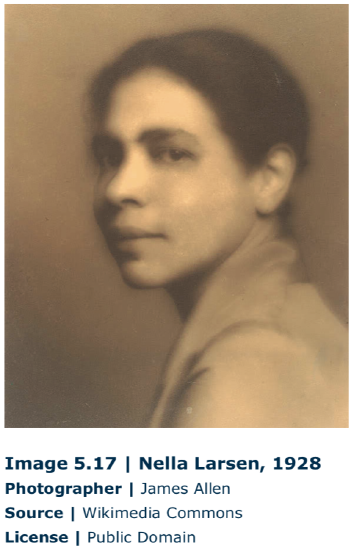5.20: Nella Larsen (1891 - 1964)
- Page ID
- 28547

Nella Larsen is a groundbreaking figure in American history. Trained professionally as both a nurse and a librarian, Larsen is the
first African-American to receive a degree from a school of library science in the United States and the first African-American woman to receive a prestigious Guggenheim Fellowship. She is also the first African-American author to publish a short story “Sanctuary,” included here in the esteemed literary magazine, The Forum. In the two novels and single short story she published over the course of her brief writing career, Larsen drew upon her personal history of living as a woman on both sides of the color line to explore nothing less than the experience of race, class, gender, and sexuality in the early twentieth century. Larsen was born in Chicago to a Danish immigrant mother and a Caribbean father. After her father abandoned the family, her mother remarried a fellow Dane, leaving Larsen as the only black member of a white household, attending separate schools than her white half-sister, and also living for years in Denmark with her white relatives. Leaving Chicago during her teens, Larsen enrolled in the racially segregated high school associated with Fisk University and then worked as head nurse of the Tuskeegee Institute’s School of Nursing. However, she chafed at what she saw as the limited mission and puritanical culture of these black institutions, even criticizing them in her loosely autobiographical novel, Quicksand (1928).
Moving to Harlem with her husband in 1920 and taking a job at the New York Public Library on 135th Street, Larsen found a more satisfactory model for black American culture in the historic neighborhood’s music and literary scene. In her first novel, Quicksand, Larsen uses her experiences growing up in a mixed-race home, working in fabled black institutions, and living in Denmark and Harlem to represent the often cruel vagaries of racial identification and class division. In her second novel, Passing (1929), Larsen writes about two light-skinned Afriimmigrant mother and a Caribbean father. After her father abandoned the family, her mother remarried a fellow Dane, leaving Larsen as the only black member of a white household, attending separate schools than her white half-sister, and also living for years in Denmark with her white relatives. Leaving Chicago during her teens, Larsen enrolled in the racially segregated high school associated with Fisk University and then worked as head nurse of the Tuskeegee Institute’s School of Nursing. However, she chafed at what she saw as the limited mission and puritanical culture of these black institutions, even criticizing them in her loosely autobiographical novel, Quicksand (1928).
Moving to Harlem with her husband in 1920 and taking a job at the New York Public Library on 135th Street, Larsen found a more satisfactory model for black American culture in the historic neighborhood’s music and literary scene. In her first novel, Quicksand, Larsen uses her experiences growing up in a mixed-race home, working in fabled black institutions, and living in Denmark and Harlem to represent the often cruel vagaries of racial identification and class division. In her second novel, Passing (1929), Larsen writes about two light-skinned African-American childhood friends, one of whom grows up to hide her race, pass as a white woman, and marry into a wealthy white family. The other embraces her black community yet secretly indulges in passing as well. Through the tale of these two women’s lives passing through different races and social classes, Larsen not only illuminates the workings of race and class in America but also the bonds of female friendship and sexuality.
After publishing two successful novels and winning a Guggenheim, the publication of “Sanctuary” in The Forum should have been another step upwards in Larsen’s career. Instead, it embroiled Larsen in controversy and was the last thing she ever published. Readers of Larsen’s tale pointed out great similarities between it and a story published eight years earlier by Sheila Kaye-Smith, “Mrs. Adis.” Both stories have the same plot, similar dialogue, and the same ironic ending. However, KayeSmith’s story takes place in Sussex, England, and features two white working-class characters. Larsen’s similarly-plotted tale takes place in the American South and features two black working-class characters. While both Larsen and the editors of The Forum defended the story, Larsen could not find a publisher for the novel she wrote during her Guggenheim fellowship. She divorced her husband for infidelity in 1933 and returned to her first career of nursing for the remainder of her life.
5.21.1 “Sanctuary”
Please click the link below to access this selection:
eiffel.ilt.columbia.edu/teach...ons/Cluster_2/ Amy's%20web%20Quest/larsen_sanctuary.htm
5.21.2 Reading and Review Questions
- Discuss why, after criticizing Jim Hammer for being “no ‘count trash,” Annie Poole still protects him.


